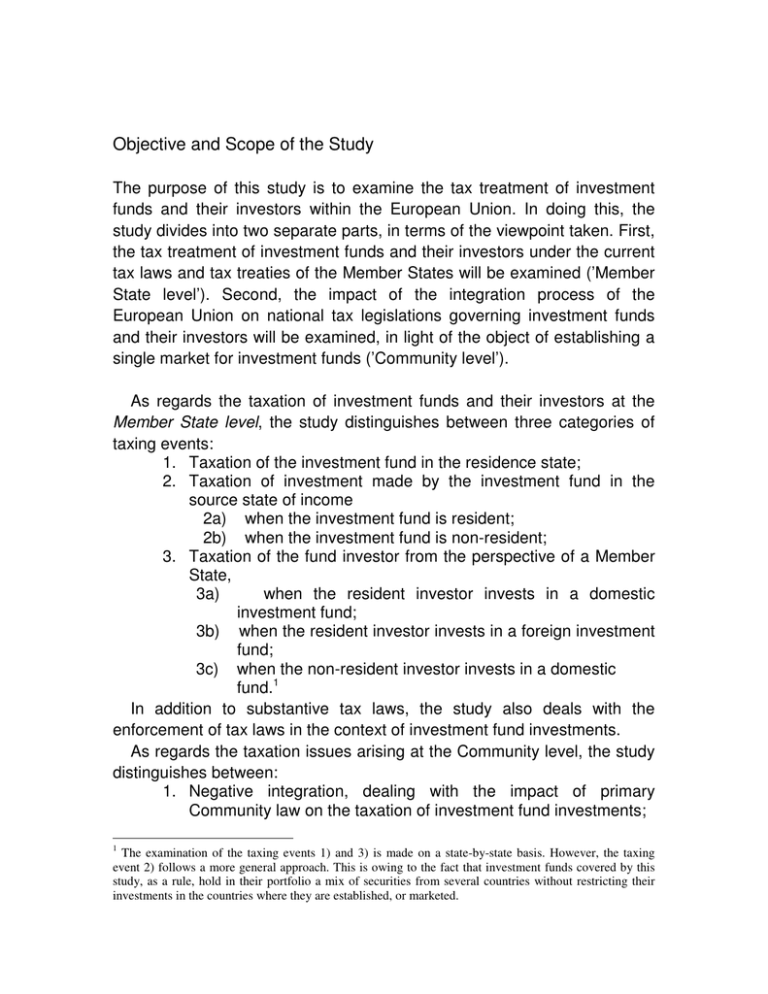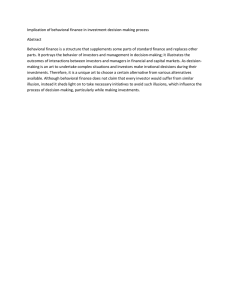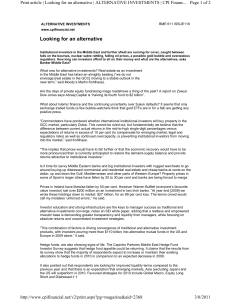Objective and Scope of the Study
advertisement

Objective and Scope of the Study The purpose of this study is to examine the tax treatment of investment funds and their investors within the European Union. In doing this, the study divides into two separate parts, in terms of the viewpoint taken. First, the tax treatment of investment funds and their investors under the current tax laws and tax treaties of the Member States will be examined (’Member State level’). Second, the impact of the integration process of the European Union on national tax legislations governing investment funds and their investors will be examined, in light of the object of establishing a single market for investment funds (’Community level’). As regards the taxation of investment funds and their investors at the Member State level, the study distinguishes between three categories of taxing events: 1. Taxation of the investment fund in the residence state; 2. Taxation of investment made by the investment fund in the source state of income 2a) when the investment fund is resident; 2b) when the investment fund is non-resident; 3. Taxation of the fund investor from the perspective of a Member State, 3a) when the resident investor invests in a domestic investment fund; 3b) when the resident investor invests in a foreign investment fund; 3c) when the non-resident investor invests in a domestic fund.1 In addition to substantive tax laws, the study also deals with the enforcement of tax laws in the context of investment fund investments. As regards the taxation issues arising at the Community level, the study distinguishes between: 1. Negative integration, dealing with the impact of primary Community law on the taxation of investment fund investments; 1 The examination of the taxing events 1) and 3) is made on a state-by-state basis. However, the taxing event 2) follows a more general approach. This is owing to the fact that investment funds covered by this study, as a rule, hold in their portfolio a mix of securities from several countries without restricting their investments in the countries where they are established, or marketed. 2. Positive integration, dealing with the impact of secondary Community law on the taxation of investment fund investments. The objective of the study is to provide a comprehensive understanding of the issues related to the tax treatment of investment funds and their investors within the European Union. To date, studies dealing with the taxation of investment funds and their investors have restricted themselves to a single issue, or at least to a limited number of issues, thereby having failed to address the issue from a broader point of view. In the author’s opinion, it is of the utmost importance to understand the interconnection of different taxing events when dealing with the taxation of investment funds and their investors. In a cross-border context, the outcome may turn out rather differently depending on whether the focus is on only one taxing event2 or on all relevant and interdependent taxing events3. By the same token, it is equally important to take into account not only substantive tax rules but also the enforcement of such rules in practice.4 A comprehensive understanding is also, in the author’s view, the prerequisite for any adequate addressing of the issues raised by the taxation of investment fund investments at the Community level. On the other hand, it is obvious that, in view of the range and ambiguity of issues related to the subject under study, to a certain extent a trade-off between comprehensiveness and thoroughness must be made within the limits of one study. In this study, it is made in favor of the former. The disadvantage of the chosen approach is that the examination cannot be completed with regard to each and every possible detail of the matter. In this respect, this study aims to take a pragmatic approach, in that the discussion will not extend far beyond the limits set by practical constraints. In fact, practical constraints, whether on the side of tax authorities or taxpayers, should not be neglected in studies of tax law.5 The requirement for efficiency in taxation restricts, to a certain extent, the possible interpretations and applications of tax rules.6 2 For example, taxation in the source state of income. For example, taxation in the source state of income and in the residence state of the investor. 4 In particular, this is important in an international context, because many of the issues arising are related to possibilities of enforcing tax laws in practice. See Vapaavuori (1991) 7. 5 For the importance of practical matters in the field of tax law, see Tikka (1972) 69-73. 6 See Tikka (1972) 87. 3 In view of the significant number of issues to be covered, careful restriction of the scope of the study is of great importance. This study considers the taxation of underlying investors of investment funds to the extent that they are individuals. In the first place, this is justified by the fact that households generally constitute the most significant category of underlying investors in the investment funds covered by this study. In particular, this holds true with respect to equity funds which not only traditionally have been the most popular type of fund7, but which also have been the context for the most interesting taxation issues. Generally speaking, the statistics usually give a somewhat distorted view of the significance of households as fund investors, because in most cases there is – behind the figures representing the ownership by the category of insurance companies – hidden ownership by households acting as pension or life assurance policyholders.8 However, in this study only individual investors holding units in the investment fund directly without other intermediaries are considered. Consequently, investors participating indirectly in the investment fund on the basis of pension or life assurance arrangements through insurance companies are not considered.9 Furthermore, attention will not be paid to pension or other savings schemes which entail special rules concerning the tax deductibility of contributions paid to or tax liability for income received within such schemes by investors.10 It is also presumed for the purposes of this study that the income derived by the individual investor is not classified as professional or business income but is taxed in accordance with the rules applied to income derived in the course of a non-business or nonprofessional savings or portfolio investment activity.11 7 Within the European Union, 31 per cent of UCITS were equity funds, 32 per cent bond funds, 21 per cent money market funds, 14 per cent balanced funds and 2 per cent other funds. See FEFSI (2003). It must also be mentioned that the relative proportion of equity funds varies significantly depending on the performance of stock markets, whereas the popularity of bond funds is more stable. The popularity of money market funds depends often reversibly on the success of equity funds. This is explained by the fact that the money market funds often serve as a ’parking place’ for money not invested in stock markets when times are bad. 8 The information is based on an interview given by Markku Savikko, the CEO of Sijoitusrahastoyhdistys (the Finnish Mutual Funds Association) at Arvopaperi Online (http://www.arvopaperi.fi) on 3.5.2001. 9 In such a case, the insurance company generally is the legal owner of the assets invested in an investment fund. It follows that the taxing issues related to such indirect fund investments may differ from those related to direct fund investments. 10 An example of such a scheme is the individual savings account (ISA) in the United Kingdom. The return on investments in an ISA is tax exempt. See European Tax Handbook 2003, 688. 11 Often the tax rules applicable differ, depending on whether the activity is classified as business or private activity. It also follows that the taxation of companies or tax-exempt institutions as fund investors will not be covered by this study. This can, in the first place, be justified by the relatively lower significance of companies and tax-exempt institutions, as compared with private investors, as participants in the funds covered by this study, though this may vary depending on the country and fund type in question.12 As regards companies, it may be also argued that behind companies there are eventually shareholders which are often households. However, taking corporate investors into consideration would add another tax subject to the chain between the individual investor and the investment fund, thereby adding significantly to the complexity of the study. Owing to the many possible variables resulting from the number of Member States of the EU, as well as from the taxing events to be considered, not all the Member States can be covered to keep the material under study manageable.13 Therefore, the study is generally restricted to five selected Member States. However, references to, or comparisons with, non-selected Member States will also be made, when appropriate. The primary criterion for selecting the Member States to be covered has been their economic importance in terms of the size of the market area for investment funds, or of the volume of assets under management in investment funds established in the jurisdiction. The Member States included on the basis of both the size of the market area and the amount of managed assets are Germany, France and the United Kingdom. In practice, each of them not only has a well-established domestic investment fund industry, but also attracts a large number of foreign investment funds from other Member States to market their units cross-border, due to the high number of prospective investors. The Member State chosen solely on the basis of its importance as a state in which investment funds are established is Luxembourg. It not only accounts for 23 per cent of 12 For example, in Finland non-households held some 71 per cent of the units in Finnish investment funds. See RATA (2003). However, the relatively high proportion is partly explained by the fact that money market funds are likely to be mainly owned by institutional investors and corporations. 13 Another approach would have been to consider the taxing problems in the area of investment fund investments at a more general level, in contrast to the country-by-country approach adopted in this study. However, due to the complexity of taxing problems in the area of investment fund investments, it was considered preferable to include a limited number of involved Member States. A country-by-country approach allows for a more thorough examination of taxing problems arising in cross-border investment fund investments between the selected Member States. However, in order to ensure a more rigorous examination, the number of selected Member States must of course be limited. European investment funds in terms of assets under management but also for some 80 per cent of the investment funds marketed across the borders14. In line with their importance, Luxembourg investment funds are also used as the main example when considering the taxation in other Member States of foreign investment funds and income from foreign investment funds. Conversely, the taxation of Luxembourg investors will not be considered because of the relatively low significance of the issue. Finland has been chosen for this study mainly because of the nationality of the author of the study. However, Finland may also be regarded as an interesting example of a country with a relatively young and small but rapidly-growing investment fund industry. With a view to generalizing the results of the study, the selected Member States provide sufficient variation in terms of tax treatment. Germany has a long tradition of following strictly the so-called principle of transparency, which at the same time has led to a very complicated tax regime. France is another example of a country adhering to the same principle, though with greater laxity. The United Kingdom in turn has a distinct tax regime in that it treats investment funds and income there from much in the same way as in the case of ordinary companies. Finland is an example of the country with a pragmatic grasp of the taxation of investment funds and income there from, characterized by the absence of specific tax rules governing the issue. However, in view of the wide variety of tax regimes adopted by different Member States, the study inevitably has its limits as to the generalization of the results to all Member States. Several limitations must also be made in terms of the types of investment fund to be covered by the study. Since this study takes the perspective of the European Union, the natural criterion, in terms of the types of fund to be covered by the study, is their qualifying as investment funds within the meaning of the UCITS Directive. In line with the scope of the Directive, only investment funds making portfolio investments in transferable securities and other financial instruments are included. This limitation has important bearings when considering the tax treatment of non-resident investment funds in the source state of income under national tax rules and relevant tax treaties. Firstly, investment funds covered by the 14 See Lipper Analytical Services. study are treated – for the purposes of domestic law and tax treaties – as portfolio investors, in contrast to direct investors with substantial holdings, or business investors engaging in the management of target companies with a fixed establishment in the source state of income. Secondly, investment funds covered by the study do not generally invest in immovable property situated in the source state, thereby making it unnecessary to consider domestic law and the tax treaty rules of taxing immovable property, which differ significantly from those dealing with movable property. The second important limitation flowing from the UCITS Directive is that only investment funds marketed to the public, in contrast to those restricted to a group of specified investors, are covered. Consequently, investment funds covered by this study are widely-held by several independent investors.15 They cannot be controlled by any party of underlying investors. This limitation often has an important bearing when considering, for example, issues related to the abuse of tax treaties or the applicability of controlled foreign corporations (CFC) legislations.16 In terms of different tax types, this study covers only taxes levied on income (income taxes), and not taxes on wealth or gift at the level of fund investors.17 Moreover, only the taxation of investment funds and their investors – but not their management companies, advisory companies or depositaries – is dealt with. The latter usually are taxed more or less in accordance with the regular tax rules applied to companies, though in certain jurisdictions special tax rules may be applied.18 Certain special taxing situations such as mergers and wind-ups of investment funds are not addressed. Nor are any kinds of indirect taxes covered.19 15 For further limitations arising from the UCITS Directive as to the type of investment funds, see the discussion in Chapter 2.2.2. 16 CFC legislations, as a rule, attribute the income of the foreign entity only to those resident investors who hold a minimum of 10 per cent of interest in the entity. See OECD (1996) 63. Of the countries covered by this study, this is the case in Finland and Germany. For Finland, see Helminen (2002a) 132. For Germany, see Endres – Thies (1998) 295. In the United Kingdom, the CFC legislation applies only to corporate taxpayers as opposed to individuals. See Collison – Tiley (2003) 34:64. In France, too, the CFC legislation applies only to corporations subject to the corporation tax. See Moerman (1999) 62. 17 Wealth and gift taxes may, of course, be of significance when making investment decisions. 18 This is the case, for example, in Luxembourg and Ireland. In principle, the taxation of management companies may also be of relevance for investors when choosing an investment object. This follows from the fact that the management company could transfer the tax benefit it enjoys to investors of the fund it manages in the form of lower management fees, thereby increasing the return on investment for investors. 19 For the VAT treatment of UCITS, see Nevelsteen – van den Plas (2003).








